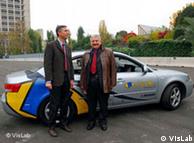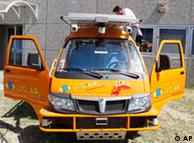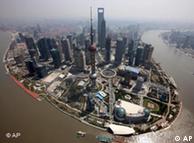In July, an
Italian company, VisLab, began a three-month journey from Parma, Italy
to Shanghai, China. But it wasn't just any road trip. Their odyssey
involves their autonomous vehicle, a bright yellow van that drives
itself along city streets and small highways. "The VisLab
Intercontinental Autonomous Challenge" is the longest and most difficult
test of autonomous vehicles to date. Previously, many of the research
team members had competed in a related autonomous driving competition
held in California, which had been sponsored by the United States
Department of Defense. Deutsche Welle spoke with the leader of VisLab,
Alberto Broggi, who leads the project and is a professor of computer
engineering at the University of Parma.
Deutsche Welle: How many weeks has it been now that your van has been out on the road?
Alberto Broggi: We
have been there for four weeks now, exactly one month. We've been
traveling for roughly 2,500 kilometers [about 1,500 miles].
How has it been going so far? I've seen that there have been some bureaucratic problems. Has it gone as you expected?
So far it's been kind
of smooth. We've had some little problems with bureaucracy, and a little
bit with the technology, but mainly bureaucracy. The vision system has
been working nicely. We have learned some things about our minor
problems when we had our little accident.
It was at the end of
one day, people were done for the day, they switched off everything
except the autonomous driver, which was on, and the vehicle started
moving and it crashed into the vehicle in front. It was a very slow
crash because they were very close, they were only four meters apart.
The speed was not high, but we learned that the design of the autonomous
driver has to be improved. And actually we have to improve some kind of
visual warning related to the presence of some system in the "on"
position. So whenever there is something that is on, we should be
warned.
 Bildunterschrift: Großansicht des Bildes mit der Bildunterschrift: Alberto Broggi (left) will meet up with his team at the end of September
Bildunterschrift: Großansicht des Bildes mit der Bildunterschrift: Alberto Broggi (left) will meet up with his team at the end of September
So it hit another car in public, or it hit another van in your caravan?
It hit one of our
vans, and it was on the side of the road. We were parked. Everybody was
sitting there beside the vehicles and talking, and nobody was taking
care of the vehicles. Nobody had the emergency stop, and then one
started moving. We now have a little dent of the vehicle in front, and
I'm sure that we will not fix it; it's now part of our history, and part
of our trip.
For those of our
readers who didn't see the first interview that I did with you, can you
remind us just a little bit about how this works. You have two vans, and
one is following the other autonomously, right?
Exactly. The first one
is driven by a human, and the second one follows. The second one looks
for the first vehicle. If the first vehicle is visible, then the second
vehicle will follow it. If the first vehicle isn't visible, then the
second vehicle will just follow the GPS information that the first
vehicle is sending back. So the second vehicle is just using its local
sensing to determine the best position on the road, and to determine the
maneuver.
And that was one of
the problems that we had when we entered Moscow. So when we entered
Moscow, the second vehicle was following the first vehicle and that was
fine. But then someone cut in between the two vehicles, and this is
something that normally happens, so it was nothing to worry about. But
in that particular case, the other traffic was so chaotic, it was so
crowded that no one was respecting the rules. We were in a two-lane
road, but there were three or four cars in a row. So lane markings were
just forgotten by the vehicles. Everybody was over the lane markings.
Our vehicle on the other hand was following the rules and was trying to
find the lane markings and stay between them. That means that our
behavioral model was different than the rest of the traffic. So we had
to turn back to manual mode.
When you say manual mode, you mean being driven by a human?
Yes, you can take over
whenever you want. In that case, the people on the vehicle thought it
was safer to stop the autonomous driving and drive manually. Because our
vehicle was driving to stay in the middle of the lane and the other
traffic was not.
That's very
interesting. Have there been a lot of moments like that, where you've
had to intervene? Does this kind of thing happen a lot?
 Bildunterschrift: Großansicht des Bildes mit der Bildunterschrift: The entire trip is 13,000 kilometers from Parma to Shanghai
Bildunterschrift: Großansicht des Bildes mit der Bildunterschrift: The entire trip is 13,000 kilometers from Parma to Shanghai
Not really. This
happened in Moscow because it was very crowded and the other traffic was
not respecting the rules, and it happened when we had to pay the toll
station. We were reaching a toll station. The second vehicle doesn't
know that you have to stop and pay. That's another nice story to tell
about - we now know that these toll stations exist. There were some
glitches that pushed us to go back to manual. Yesterday we had a fault
in our speedometer, it was not working. It was giving 100 kph, but we
were driving at 50 kph, so we had to go back to manual. It was a fault
in our system.
There have been a few
situations like this, but nothing as important as when we entered
Moscow. We really learned that you really can't rely on a single driving
mode, like we have now. We need to adapt to the local traffic, and we
need to learn how local traffic moves. And if people do not respect the
rules and do not respect the lane markings, then we shouldn't either.
We're speaking on Thursday, August 26. Where is the vehicle right now?
They
are in Saratov, which is about 500 kilometers southeast of Moscow. They
left Moscow five or six days ago and they are traveling and today they
are stopped for a presentation and a demonstration. The next stop will
be Kazan on September 1st.
Since the van left Italy, you haven't seen it, right?
No, I'm still here in Parma.
Does your team check in with you every day? Are you following it online? How are you connected to what's happening on the road?
Every three or four
hours, we get a phone call and people tell me how they're working and
the problems they have - not only myself but the team here in Parma. We
have a team here working with them in Russia. […] We will send new
hardware on September 1, when there will be the next switch of people
there.
 Bildunterschrift: Großansicht des Bildes mit der Bildunterschrift: VisLab plans on reaching Shanghai by the end of October
Bildunterschrift: Großansicht des Bildes mit der Bildunterschrift: VisLab plans on reaching Shanghai by the end of October
Can you give us a preview of what you expect to happen in the next month?
The most important
change will be weather, because right now we've been traveling in sunny,
hot weather. We're going to be going in areas where the weather will be
bad and this will threaten our systems. I'm thinking about Siberia as
one of the most difficult areas. The roads will be unpaved; there will
be big holes on the roads and dust. It will be raining a lot and the
weather will be bad. This is the biggest problem that we might have.
The vehicle will go
towards Novosibirsk, in Siberia, about 3,000 kilometers east of Moscow,
and then down south to Kazakhstan and then east towards Shanghai.
Interview: Cyrus Farivar
Editor: Kate Bowen
http://www.dw-world.de/dw/article/0,,5949666,00.html









